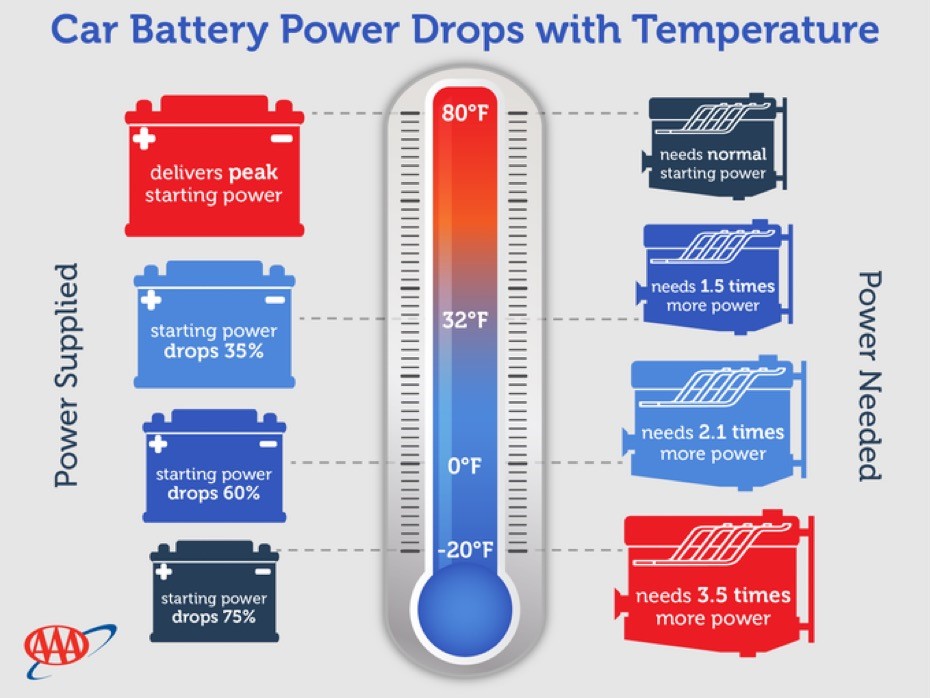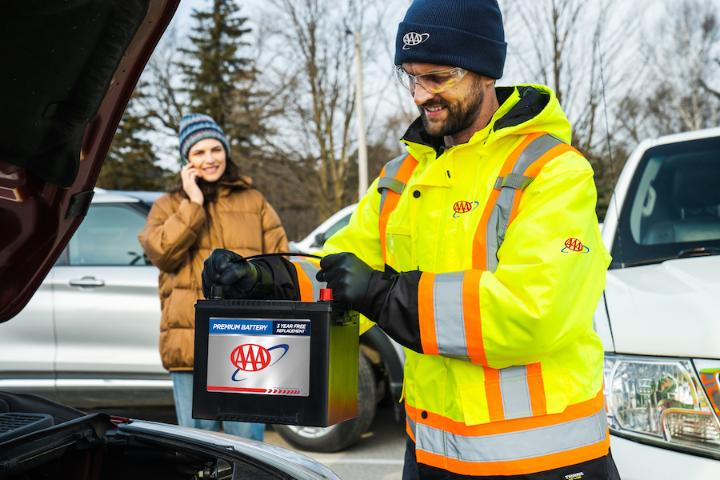With extreme arctic temperatures forecast for the area starting this weekend and throughout next week, AAA Oklahoma urges drivers to make sure their vehicles are ready for the cold.

“Winter is a tough season on vehicles,” said AAA Oklahoma spokesperson Rylie Fletcher. “Last winter (Dec. 2022-March 2023), AAA emergency roadside service crews responded to more than 58,000 calls for assistance in Oklahoma alone. The sudden onset of dangerously cold weather often leads to a spike in assistance calls, especially for dead batteries.”
Batteries
Did you know that a car battery loses a third of its power in freezing weather? Because as the air outside cools, the oil in your car thickens. Parts move slower, and your battery has to use more power to turn over and start the engine. If the temperature drops to zero or below, your battery has only HALF its power to start the vehicle.
Here are a few quick tips to help you avoid the moment when you turn the key in the ignition and nothing happens.
Warning Signs
- Your car doesn’t start immediately, or makes a clicking noise when you turn the key.
- Your headlights or interior lights are dimmer than normal, or the power windows are working slower than usual.
- You see stains or signs of corrosion on the battery itself.
- Your battery is more than three years old.
- You take a lot of short trips where the car is turned on and off often, or you have long stretches of time (weeks or months) where the car is not used at all.
What You Can Do
- Park your car in a garage, if possible. The less frigid the air is around your car, the better for your battery.
- Turn off your lights, wipers, and heater before you turn off your engine at the end of a drive to prevent an unnecessary drain on the battery the next time you start your car.
- Unplug phone chargers and USB cables for devices like iPods as soon as you turn off your engine (for the same reason as #2).
- Avoid using your car’s heater longer than you have to; heaters put high demands on your battery.
- If you see corrosion on your battery, clean it or have it cleaned by a trained technician.
- If you consistently go two weeks or longer without using your car during the winter, invest in a battery tender to keep the battery charged.
- If you plan on not using your car for an extensive period of time during winter, it is important to turn it on every day and take it for a short drive or let it run idle for 15 – 20 minutes so that it reaches operating temperatures. This provides current to the battery, allowing it to regain its charge.

If drivers experience some of the warning signs above with their battery, they are urged to have their battery charge tested. A car care center, such as an AAA Approved Auto Repair Facility (https://www.aaa.com/autorepair/), or auto parts store such as Napa Auto Parts can test a battery. And AAA members can call for a AAA Mobile Battery service technician to come out to test the battery and, if needed, replace it on site.
Other important vehicle components
AAA automotive experts also recommend drivers pay special attention to these other key vehicle components during extreme cold:
Tires
Air expands when it is heated and contracts when it is cooled. As the air temperature drops outside, so does the air pressure in your tires. Why is this important? Maintaining proper tire inflation is essential for safe driving. For every 10 degree-change in air temperature, a tire’s pressure will change by about 1-2 psi (pounds per square inch).
How to Check Your Tires:
- Check tire pressure. Colder weather can require adding air to tires. Make sure pressure levels match those found in either the owner’s manual or on a sticker found inside the driver’s door jamb, and note that pressure levels may be different for front and rear tires.
- Check tire tread. Test tread depth with a quarter. Take a quarter and insert it in to the tire tread with George Washington’s head upside down. If all of Washington’s head can be seen, it is time for new tires.
- Check for a spare tire. Motorists should know whether their vehicle comes with a spare tire (many newer cars do not). This helps AAA know whether to send a light service vehicle (to put on the spare) or a tow truck for a vehicle without a spare.
Fluids
AAA automotive experts report seeing increased numbers of vehicles in need of repair because of issues with fluids. With subzero temperatures expected, it’s critical that drivers take time to ensure proper vehicle fluids are being used, levels are correct and they are rated for the weather conditions.
- Anti-freeze/Coolant: engine anti-freeze performs a vital job when the temperature drops. It lowers the freezing point of the cooling system in winter. Failing to ensure coolant levels can handle the extremely cold temperatures could result in serious and expensive damage to the vehicle’s engine. AAA automotive experts recommend that coolant protection be at 30 below zero.
- Washer Fluid: Fill the windshield washer fluid reservoir with a winter-blend cleaning solution to prevent it from freezing and avoid damage to the windshield washer system.
How to stay safe if stranded
Whether you have a long commute to work or just need to drive a short distance to the store, preparation is key to staying safe should a vehicle breakdown happen in extremely cold temperatures.
Drivers are advised to prepare a winter emergency kit now and stow it in the trunk or cargo area of their vehicle to have it immediately available should the need arise. AAA warns, more than 40% of motorists do not carry an emergency kit in their vehicle.
The emergency kit should include:
- Fully charged mobile phone (pre-programmed with the AAA Mobile App or other rescue apps and important phone numbers including family and emergency services), and car charger or extra battery pack
- First-aid kit
- Bottled water
- Non-perishable snacks for both human and pet passengers
- Blankets
- Extra warm clothing (coat, gloves, hats, scarves)
- Flashlight with extra batteries
- Bag of abrasive material for traction (e.g. sand, salt, coarse cat litter)
- Snow shovel
- Ice scraper with brush
- Jumper cables and or portable jump-starter pack
- Warning devices (flares or triangles)
- Basic toolkit (screwdrivers, pliers, adjustable wrench)
- Extra winter-blend windshield washer fluid
Many of the winter emergency items listed above – plus pre-assembled multi-item kits – are available, at a discount to AAA members in the online store at AAA.com. Some emergency kits may also be available at local AAA retail locations.

















